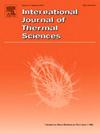Nusselt number predictive model for Taylor–Couette flow with circumferential grooves under different operating parameters
IF 4.9
2区 工程技术
Q1 ENGINEERING, MECHANICAL
International Journal of Thermal Sciences
Pub Date : 2025-05-19
DOI:10.1016/j.ijthermalsci.2025.110009
引用次数: 0
Abstract
Taylor–Couette flow (TCF) is crucial for rotating machinery in chemical processing, energy systems, and other fields. Previous studies have mainly focused on fluid dynamics characteristics, while the heat transfer mechanism has been insufficiently explored, especially in TCF systems with circumferential grooves. A systematic investigation of the thermal performance with circumferential grooves was conducted through a combination of numerical simulation and machine learning (ML). Key operating parameters (angular velocity, inlet flow rate, and inlet temperature) were selected for a three-factor, five-level experimental design, providing training data for using Polynomial regression, Random forest, and XGBoost models. The comprehensive evaluation results indicate that the Polynomial regression heat transfer predictive model on the test set not only has the highest coefficient of determination (R2 = 99.2 %) but also has the lowest mean absolute error (MAE = 6.5) and root mean square error (RMSE = 8.8), demonstrating strong predictive fidelity. The 95 % confidence intervals of the results were determined based on bootstrap sampling, and nine combinations of features, such as angular velocity, significantly affect heat transfer performance based on the Student's t-test. The findings establish a reliable machine learning framework for optimizing TCF heat exchangers while providing a basis for elucidating coupled thermal fluid phenomena in modified Taylor–Couette systems.
不同工况参数下带周向槽Taylor-Couette流动的Nusselt数预测模型
泰勒-库埃特流(TCF)对化学加工、能源系统和其他领域的旋转机械至关重要。以往的研究主要集中在流体动力学特性上,而对传热机理的探讨不够充分,特别是在具有周向沟槽的TCF系统中。通过数值模拟和机器学习(ML)相结合的方法,对具有周向凹槽的热性能进行了系统的研究。选取关键运行参数(角速度、进口流量和进口温度)进行三因素五水平实验设计,为多项式回归、随机森林和XGBoost模型提供训练数据。综合评价结果表明,测试集上的多项式回归传热预测模型不仅具有最高的决定系数(R2 = 99.2%),而且具有最低的平均绝对误差(MAE = 6.5)和均方根误差(RMSE = 8.8),具有较强的预测保真度。结果的95%置信区间是基于bootstrap抽样确定的,并且根据Student's t检验,角速度等九种特征组合显著影响传热性能。研究结果为优化TCF换热器建立了可靠的机器学习框架,同时为阐明改进Taylor-Couette系统中的耦合热流体现象提供了基础。
本文章由计算机程序翻译,如有差异,请以英文原文为准。
求助全文
约1分钟内获得全文
求助全文
来源期刊

International Journal of Thermal Sciences
工程技术-工程:机械
CiteScore
8.10
自引率
11.10%
发文量
531
审稿时长
55 days
期刊介绍:
The International Journal of Thermal Sciences is a journal devoted to the publication of fundamental studies on the physics of transfer processes in general, with an emphasis on thermal aspects and also applied research on various processes, energy systems and the environment. Articles are published in English and French, and are subject to peer review.
The fundamental subjects considered within the scope of the journal are:
* Heat and relevant mass transfer at all scales (nano, micro and macro) and in all types of material (heterogeneous, composites, biological,...) and fluid flow
* Forced, natural or mixed convection in reactive or non-reactive media
* Single or multi–phase fluid flow with or without phase change
* Near–and far–field radiative heat transfer
* Combined modes of heat transfer in complex systems (for example, plasmas, biological, geological,...)
* Multiscale modelling
The applied research topics include:
* Heat exchangers, heat pipes, cooling processes
* Transport phenomena taking place in industrial processes (chemical, food and agricultural, metallurgical, space and aeronautical, automobile industries)
* Nano–and micro–technology for energy, space, biosystems and devices
* Heat transport analysis in advanced systems
* Impact of energy–related processes on environment, and emerging energy systems
The study of thermophysical properties of materials and fluids, thermal measurement techniques, inverse methods, and the developments of experimental methods are within the scope of the International Journal of Thermal Sciences which also covers the modelling, and numerical methods applied to thermal transfer.
 求助内容:
求助内容: 应助结果提醒方式:
应助结果提醒方式:


